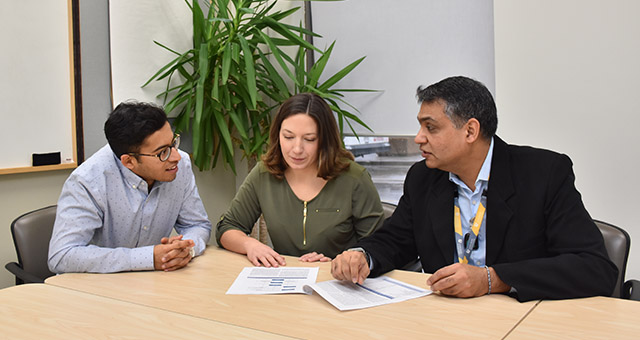

Most days, Donna Watson has a shower, eats breakfast and gets ready for her day. Along with these morning habits, she also does one important activity for both her mental and physical health – she meditates.
“It helps me to stay in tune with my body and my mind. And with myself. I now feel more confident and capable of going about my daily living without the fear and panic attacks that I was once facing. I feel more relaxed, I worry less and I take one day at a time,” explains Donna.
In the past, she has struggled with depression, anxiety and other symptoms related to having PTSD (Post Traumatic Stress Disorder).

Depression in older adults can be a disabling and debilitating condition often leading to other chronic problems such as heart disease.
A new research study from Lawson Health Research Institute and Western University found that meditation can be implemented easily and effectively as a therapy to treat late-life depression and mood related symptoms.
“Current treatment options include cognitive behavior therapy, supportive therapy and medications that can have side effects and are often not preferred by these patients,” explains Dr. Akshya Vasudev, Associate Scientist at Lawson and Associate Professor at Western University’s Schulich School of Medicine & Dentistry. “Older adults have a higher rate of comorbid medical conditions that may be associated with poor tolerability of antidepressants and a poorer response to medications.”
For Donna, she feels her medication has a place, but she wanted to feel more than "stable." She wanted to go back to a healthy, normal way of living. When she was offered the opportunity by Dr. Vasudev to learn meditation, she felt desperate and was open to any help she could get. After one session, she knew this was something that could help her. She dedicated herself to learning this technique and weaving it into her daily life.

Meditation has been shown to have positive impacts while also being easy to facilitate, lacking in negative side effects and delivered at a low long-term cost. The research team, led by Dr. Vasudev, conducted a unique study exploring a meditative technique that has not been investigated before with people experiencing late-life depression.
“We wanted to determine if a Sahaj Samadhi Meditation (SSM), which is easy to learn and can be practiced in a clinical setting as well as at home, could improve depressive symptoms and Heart Rate Variability (HRV), a physiological predictor of subsequent heart disease, in the elderly,” says Dr. Vasudev, who is also a Consultant Geriatric Psychiatrist at London Health Sciences Centre (LHSC).
There is no existing research specifically on SSM for use as a therapy, especially in a randomized controlled setting. It has been available in India and many other places in the world for nearly 35 years and has led to improved quality of life for those practicing.
The randomized clinical trial involved 83 research patients ages 60-85 from LHSC and St. Joseph’s Health Care London, as well as the regional community, who either received the standard treatment or also practiced the meditation technique.
Participants received four two-hour sessions taught by trained instructors, as well as 11 weekly follow-up sessions while also being able to practice on their own daily. SSM is unique compared to other meditative techniques because it uses a tailored mantra that helps the person achieve a higher state of consciousness and awareness instead of relying on focusing techniques.
Those practicing the meditation reported a significant improvement in the depressive symptoms compared to the group who received only the regular treatment.
“The meditation group had a three times higher chance of going into remission, no longer meeting criteria for depression, compared to usual treatments. In addition, there were no observed side effects,” notes Dr. Vasudev. “We did not find any statistically significant differences in HRV measures between the two groups.” The study is the first to show that this particular form of meditation is beneficial as an adjunctive therapy to regular treatment options.

From left, Jayneel Limbachia and Emily Ionson were the study’s first co-authors, shown here with principal investigator Dr. Akshya Vasudev. Not pictured are Klajdi Puka, Ronnie Newman, Dr. Soham Rej, Dr. Stephen Wetmore and Dr. Amer Burhan.
Since the meditation can be done easily and from anywhere, people can use it as a tool for their every lives. Donna explains that whenever she needs a break or is feeling overwhelmed, she can do even short meditation sessions to help her cope with the day. Even when she is in a meditative state, which for her means she is essentially thinking of nothing, she is still present and aware of her surroundings.
“I would tell anyone struggling to just try it. It can’t hurt! Part of the reason why it helps is because you can give up whatever is in your mind. Whatever is worrisome or disturbing. Just give it up and let it go through meditation.” She explains that some people might find it too simple, but it really does help.
If you ask Donna today, she would tell you that she no longer suffers from the depression or other symptoms that she was experiencing.
“I feel the way I used to before I got PTSD. It is a gradual thing and I know I can get down in the pits once in a while. But if I can get myself back into meditation, I can deal with anything. I have my life back.”
Late-life depression affects 300,000 older adults in Canada and is a significant health challenge. As our population ages, we need to find sustainable ways to manage depression and meet the unique needs of these patients, adds Dr. Vasudev.
The study “Effects of Sahaj Samadhi meditation on heart rate variability and depressive symptoms in patients with late-life depression” is published in The British Journal of Psychiatry.